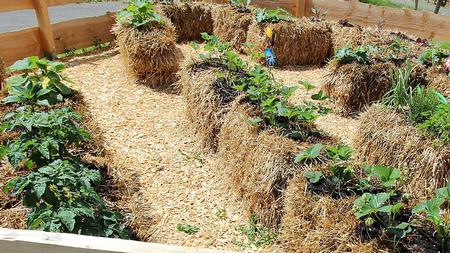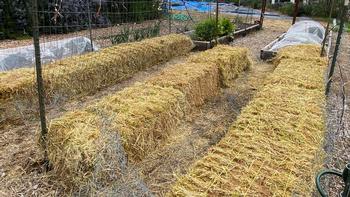News from the Edible Demo Garden
May 2021: Straw Bale Gardening

Straw vs. Hay
Straw is the plant material leftover after grains have been harvested, for example, from wheat, oats, and barley. Straw is composed of only the stems of the plant and has no nutritional value. Hay is what is fed to animals and has both the nutritious seeds and the leaves. Because it contains seeds, you would never want to use hay in your vegetable garden.
We use rice straw because it is less likely to have viable seeds in it. Straw can be purchased from area feed stores. Because we are located on an organic farm, we buy certified organic rice straw for about $11 per bale. Nonorganic bales will be less. At this time of year, you might also find bales for free that a farmer has left over or a friend wants to give away!
Straw Bale Gardening
From the creation of the Edibles Demo Garden, we have experimented with straw bale gardening. It is basically a container garden using bales as the container. Because a bale has no nutritional value, before planting the bales are conditioned with water and organic fertilizer. The addition of fertilizer starts the composting process that will create a source of nutrition for our plants. We have found that our summer and winter squash as well as cucumbers thrive in our bales. At the end of the season, we take our bales apart and use the composted insides as a nutritious fertilizer. In a side-by-side comparison, horseradish grew faster and with more lush growth using our decomposed straw than using our farm’s compost.

Here's how to condition your straw bales before planting.
Straw Bales Use Less Water
You can take advantage of the rainy season by getting your bales in place early for the conditioning process. Straw is hollow and as the bales are watered or rained on, the droplets are trapped in the straw by a natural attraction called cohesion. A straw bale can hold between 3-5 gallons of water at the beginning of the growing season so you only need to water in small spurts. As the season progresses, you increase the water as needed but always using less than you would require for gardening in soil, a real plus for our drought ridden times.
Straw as a Mulch
After removing the composted insides of our bales for use as fertilizer, we have non-composted straw left over that we use for mulch. Mulch on our vegetable beds is a must for the hot months ahead. There are many reasons to use mulch from improving soil health to adding organic matter. But for gardeners in the drought years we are experiencing, mulch is an absolute must for preventing soil moisture evaporation. Straw is great as mulch for vegetable gardens. Add to your bare soil at a depth of 3-5 inches pulling it back to keep it from touching plant stems. Because straw decomposes quickly, you will need to add more straw as the season progresses to keep the soil well insulated from the heat.
Straw as Mulch for Strawberries and Potatoes
We use straw under our strawberries so that they don’t touch the soil. And this year, we planted potatoes in soil but will cultivate them by adding layers of straw as the plants grow. What a great material for our gardens!
For additional information on ways to conserve water in your vegetable garden, see the March EDG news.
